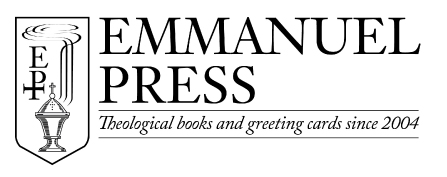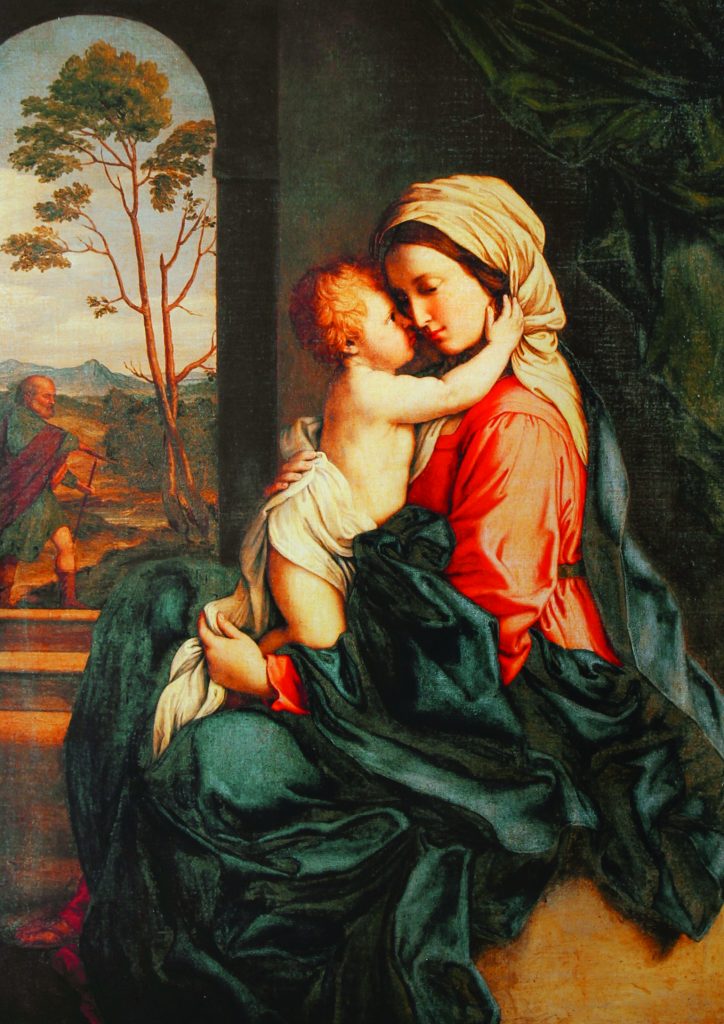Introducing our newest Christmas card…God Most High
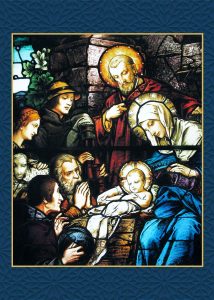 This year we are pleased to add a new Christmas card to our collection: God Most High. Here the holy family is depicted in stunning stained glass, gathered together with shepherds in adoration of the Christ child. The inside text is Stanza 3 of Martin Luther’s Christmas hymn, “From Heaven Above to Earth I Come”:
This year we are pleased to add a new Christmas card to our collection: God Most High. Here the holy family is depicted in stunning stained glass, gathered together with shepherds in adoration of the Christ child. The inside text is Stanza 3 of Martin Luther’s Christmas hymn, “From Heaven Above to Earth I Come”:
This is the Christ, our God Most High,
Who hears your sad and bitter cry;
He will Himself your Savior be
From all your sins to set you free.
Luther wrote the text of this hymn in 1534 as a sort of pageant or Christmas devotion for his own family. In fact, this particular stanza is addressed to the shepherds as part of “an extended paraphrase of the words of the angel from Luke 2:11–12. Luther goes beyond a simple retelling of the story to emphasize the great joy that comes from knowing that Jesus came ‘from all your sins to set you free,'” as Pr. W.H. Otto observes in a Lutheran Witness article from 2009. His entire article is worth reading to understand the hymn’s structure and how its writing was influenced by the 14th-century medieval folk tradition of the garland song.
Now Available: The Conduct of the Service
 We are pleased to announce that The Conduct of the Service, an invaluable resource for conducting the liturgy of the Church, is back in print. This book was first published by Redeemer Press in 2003, then reformatted and updated with pictures and diagrams in 2006. In 2012, Emmanuel Press assumed the management and distribution of the remaining copies, and we now offer this new printing with the same cover and content as the 2006 edition. This excerpt from the Preface written by Pr. David Petersen and Pr. Michael Frese explains its origin:
We are pleased to announce that The Conduct of the Service, an invaluable resource for conducting the liturgy of the Church, is back in print. This book was first published by Redeemer Press in 2003, then reformatted and updated with pictures and diagrams in 2006. In 2012, Emmanuel Press assumed the management and distribution of the remaining copies, and we now offer this new printing with the same cover and content as the 2006 edition. This excerpt from the Preface written by Pr. David Petersen and Pr. Michael Frese explains its origin:
“Most of Piepkorn’s students had little experience with the ceremony, reverence, and decor that flowed from him so naturally. They recognized in his liturgical actions something of the Church that they wanted to imitate. Fortunately for us they continued to press him, until finally he relented and produced The Conduct of the Service, revised in 1965. It was printed by the Concordia Seminary print shop in St. Louis and sold in the seminary bookstore. He wrote it for his students, at their insistence. He never promoted it. And thus, it never enjoyed widespread dissemination and was quickly lost to the Church. Over the years it has been much sought after and much photocopied, but the copies that still exist are mostly torn and dog-eared.
“When he finally acquiesced to their demands, his training and preference for
systematics showed itself. He came at the description of ceremonies in a unique and
systematic way. He went after the rules. The rules he used are the rubrics prescribed in The Lutheran Hymnal of 1941 and in the companion volume for that hymnal, The Lutheran Liturgy. We have reproduced the latter in an appendix for easy reference. Incidentally, those rubrics have never been replaced by the LCMS. Unless they are explicitly contradicted, replaced, or restated in new Rites provided by the Commission on Worship, they are STILL the guide for the conduct of the Services in our churches. Where they have been updated and revised, Piepkorn’s descriptions and explanations tend to make even more sense. Thus, this is the best work up to our day on the practical execution of liturgy in the LCMS…
“It is our prayer that these words would again serve the Church and help unclutter Her Services from things that hinder and distract God’s people from His gifts.”
Read the full prefaces and take a look at the Table of Contents here.
Weedon endorses Liturgical Forms
 “If Matthew Carver’s translation of Friedrich Lochner’s The Chief Divine Service left you hungering and thirsting for more goodies in English from that finest liturgiologist of the early Missouri Synod, the volume you hold in your hands now will certainly satisfy that hunger and thirst.
“If Matthew Carver’s translation of Friedrich Lochner’s The Chief Divine Service left you hungering and thirsting for more goodies in English from that finest liturgiologist of the early Missouri Synod, the volume you hold in your hands now will certainly satisfy that hunger and thirst.
“Lochner spreads a veritable feast before you for nearly every occasion where the pastor is expected to serve up the Word. Of course, the Mass is central (and he offers some more thoughts on that too!), but it does not exist in isolation. Put together at the request of his fellow pastors, Lochner again ransacks the Church Orders to present an Agenda that draws upon the vast wealth of our Church’s liturgical tradition for occasional services. Here you will discover ceremonies ranging from consecration of cornerstones and organs and churches, to ordinations and installations; from the children’s Christmas Service (delightedly catechetical!) to an order for Good Friday; from Baptism and Marriage to excommunication and private confession at Vespers. The list goes on and on! And with it all he includes a fine collection of prayers and collects.
“Liturgical Forms is truly the 19th century’s Pastoral Care Companion. Yet again, we find ourselves deeply in Matthew Carver’s debt as he continues to bring into English important works that give us vital insights into the lex orandi of the Lutheran Church.”
William Weedon, Assistant Pastor
St. Paul Lutheran Church, Hamel IL
Catechist on LPR Podcast: The Word of the Lord Endures Forever
A Daily, Verse-by-Verse Bible Study with the Church, Past and Present www.thewordendures.org
Now Available: Liturgical Forms by Friedrich Lochner
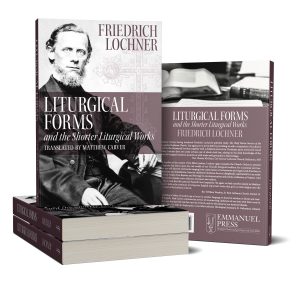
Liturgical Forms represents the latest stage in bringing Friedrich Lochner’s works into English, which was begun by Matthew Carver’s translation of The Chief Divine Service (2020). It shows the other facets of the liturgical life of the early Missouri Synod and particularly the interest in and desire for suitable and historically justifiable rites drawn from old, orthodox Lutheran sources.
It is comprised of two parts: first, the Liturgical Forms, a work originally published in 1895 as a compilation material (rites, prayers, etc.) from Lochner’s liturgical journal; second, shorter liturgical works that were published separately, including an order of service for Good Friday, an order for a children’s Christmas program, and a pamphlet called Feasts and Usages, a sort of explanation of the differences between Lutheran and Roman Catholic liturgical practices. Find the Table of Contents here.
This is an excellent resource for those interested in liturgy and the history of the Missouri Synod and of Lutheranism in America, providing the reader with ample reason to appreciate and thank God for Lochner’s faithful work and Carver’s superb translation.
“Matthew Carver, having translated Friedrich Lochner’s splendid study, “The Chief Divine Service of the Evangelical Lutheran Church,” has again put us in his debt by providing us with a translation of Lochner’s work on the Occasional Services, together with a children’s service for Christmas and a service for Good Friday. Lochner does not create services out of whole cloth but, relying on his deep knowledge of the Church’s liturgical treasures, presents us with works well grounded in that heritage.”
Pr. Charles McClean – Our Savior Lutheran Church, Baltimore, MD
______
Friedrich Johann Carl Lochner (1822–1902), born in Nuremberg, came under the influence of Wilhelm Löhe and moved to America, where he served as a Lutheran pastor and an instructor focusing on liturgics. During his time here, co-founded a teacher’s school in Milwaukee, WI, and was a professor at the seminary in Springfield, IL. Meanwhile, he edited and published a liturgical monthly, Liturgische Monatsschrift (1884–1886) to supply pastors with liturgical forms, prayers, and information lacking in the available agendas. Besides liturgical works he also published the polemical Notwehrblatt, which opposed Grabau, two devotional works for Passiontide and Easter, and a series of Epistle sermons.
Matthew Carver, a freelance translator specializing in German and Latin, lives in Nashville, TN, with his wife Amanda, a graphic designer, and their two sons Edward and Alfred.
Available soon: The Conduct of the Service – Pre-order and save 10%
 We are pleased to announce that The Conduct of the Service is currently in the process of being reprinted. We’ll have more information soon on an expected release date. In the meantime, pre-order now to save 10% and be among the first to receive a copy from the new print run.
We are pleased to announce that The Conduct of the Service is currently in the process of being reprinted. We’ll have more information soon on an expected release date. In the meantime, pre-order now to save 10% and be among the first to receive a copy from the new print run.
Gathering together works from Dr. Arthur C. Piepkorn and Rev. Charles McClean, this book is an invaluable resource for conducting the liturgy of the Church as it serves to teach reverence and encourage uniformity and beauty in worship.
The following is an excerpt from the first section, entitled “Notes on Reverence”:
________
There is really only one basic rule of good form: “Be courteous!” And similarly there is really only one basic rule of altar decorum: “Be reverent!” Every other rule is simply a practical amplification of this basic charge.
To be reverent we must first of all be humble. We are ministers — ministers of Christ, serving Christ in the room and in the name of fellow-sinners. We minister not because of any virtue in ourselves. Our sufficiency is of God. We minister as temples of the Holy Ghost, as being bound in sacramental union to the Lord of the Church, as kings and priests living in mystic communion with the Most Holy Trinity, as those whom Christ has chosen that we might be with Him and that He might send us forth to preach (St. Mark 3, 13). We minister under the aspect of eternity and in the Presence of the Divine Majesty. Wherever we stand, we are on holy ground. In such a ministry there is no room for pride, only for all-pervading humility.
To be reverent we must be prepared. We must know what we are doing, and why we are doing it. The physical preparations, as far as may be, should be taken care of well in advance. There should be no last-minute running to and fro, no hasty final preparation, no distressed paging about. A meditation, brief if need be, but as long as the time permits, ought never to be overlooked; spiritual preparation is more essential to reverence than the proper ordering of the physical adjuncts.
To be reverent we must be calm. The unforeseen, the accidental, the disturbing must not be permitted to distract us. We are God’s ambassadors and God’s servants. We are speaking for and to God. Our entire lives ought to be, and our public ministry must be en Christo – in Christ! So must the calm peace of the changeless Christ in our souls be reflected in our outward demeanor.
-Dr. Arthur C. Piepkorn, p. iii
“…for he will save his people from their sins.”
Share the good news of our Savior’s birth with Christmas cards that combine stunning imagery with words of Scripture and beloved hymns.
Savior (left) shows the infant Christ standing on the lap of the Virgin Mary, who gently receives her child’s embrace. We see St. Joseph through the archway. This 17th-century painting by Italian artist Giovanni Battista Salvi da Sassoferrato is a tender portrayal of the bond between mother and son. Yet this Son is the Savior of the world, as is echoed in the inside greeting: “She will bear a son, and you shall call his name Jesus, for he will save his people from their sins” (Matt. 1:21).
An Army of Angels Leads to the Nativity
Glory to God depicts an oil on canvas painting, “Seeing Shepherds” by Daniel Bonnell. The inside text echoes the cover with a stanza from “O Come, All Ye Faithful”:
Sing, choirs of angels, sing in exultation, Sing, all ye citizens of heaven above! Glory to God in the highest; O come, let us adore Him, Christ the Lord!
As Mr. Bonnell explains, “This is the nativity from the perspective of the viewer. The viewer becomes one of the shepherds as you witness an army of angels leading to the nativity.” The angels appear to the humble shepherds standing among their herd of sheep, filling the sky with brilliant light and pointing to the manger in Bethlehem.
As with all of our Christmas cards, this design is exclusive to Emmanuel Press.
Christmas Cards that Focus on Christ
Share the good news of our Savior’s birth with Christmas cards that combine stunning imagery with words of Scripture and beloved hymns.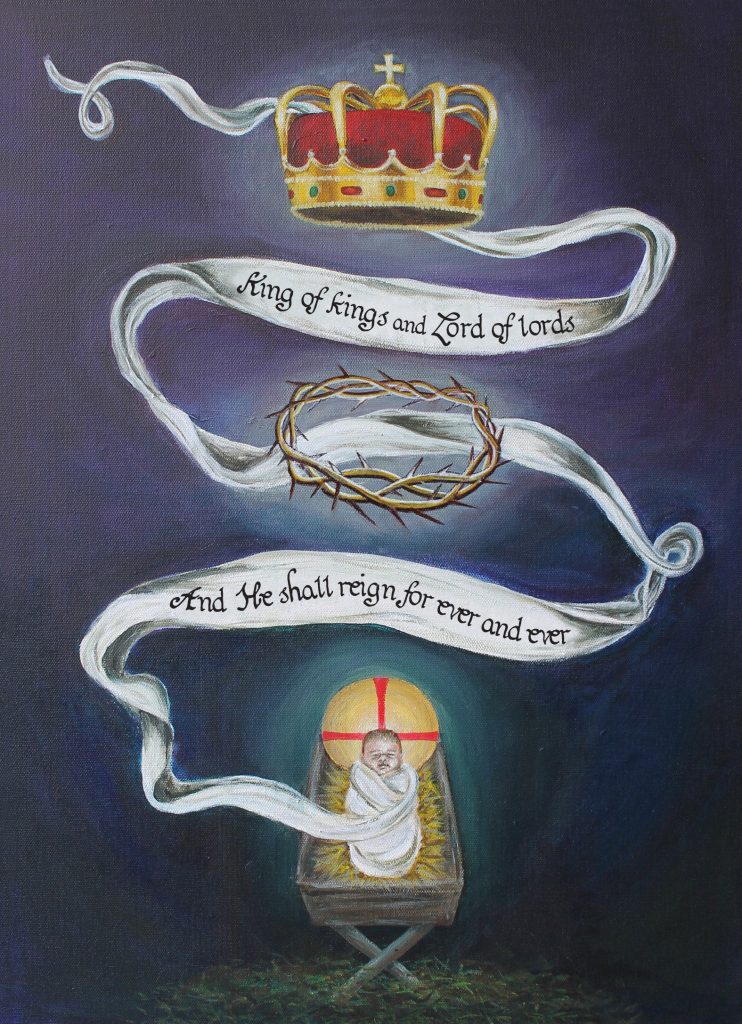
Messiah (right) features an acrylic painting on canvas by Meghan Schultz, a Lutheran artist with whom we often collaborate (see biography below). The three-rayed nimbus around the Christ Child’s head represents His deity. Swaddling cloths weave through a crown of thorns and a king’s crown, confessing that Jesus was born to die that we may live, and He reigns eternally as King. Ever with an eye to symbolism, Meghan notes that the dark blue hues around the manger below transform to purple above to signify royalty. Well-known words from Handel’s Messiah echo the meaningful imagery of the art on the cover while the inside text proclaims, “For unto you is born this day in the city of David a Savior, who is Christ the Lord” (Luke 2:11).
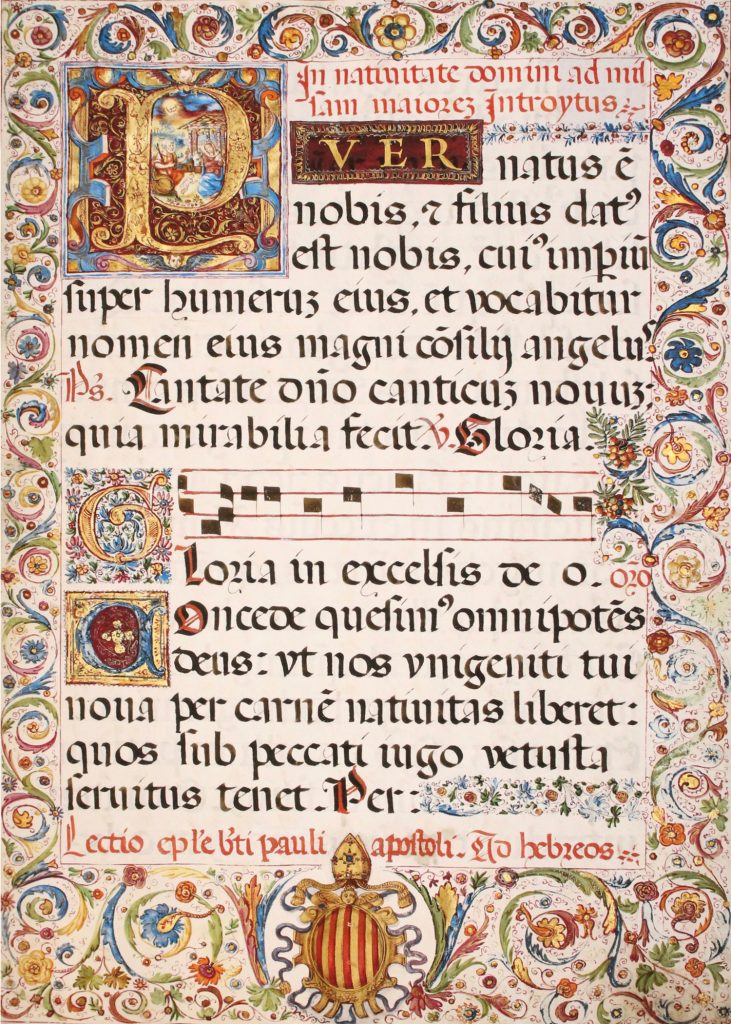 Puer Natus (left) is a 16th-century illuminated manuscript from a Latin Divine Service book in Italy. The inside text is Isaiah 9:6, which also appears on the cover: “For to us a child is born, to us a son is given…and his name shall be called Wonderful Counselor, Mighty God, Everlasting Father, Prince of Peace.”
Puer Natus (left) is a 16th-century illuminated manuscript from a Latin Divine Service book in Italy. The inside text is Isaiah 9:6, which also appears on the cover: “For to us a child is born, to us a son is given…and his name shall be called Wonderful Counselor, Mighty God, Everlasting Father, Prince of Peace.”
As you’ll read on our Christmas cards page, you can create a custom assortment of Christmas cards, whether it is one design or a mixture of all thirteen. Choose from a variety of styles, including stained glass, illumination, triptych, classic art, and original commissioned pieces.
*Meghan Schultz’s background is in graphic design and advertising with a special interest in fine art and calligraphy. In the past few years she has completed countless freelance projects for churches, schools, and Christian organizations and has created a body of liturgical artwork which can be found in her Etsy shop (redletterartdesign.etsy.com). Meghan hopes that her artwork serves as a tool for Christians in centering their life around the Church Year as they serve their neighbor through their vocations. She is a member of Redeemer Lutheran Church in Fort Wayne, Indiana.
Introducing our newest Christ-centered Christmas card…
Share the good news of our Savior’s birth with Christmas cards that combine stunning imagery with words of Scripture and beloved hymns.
This year we are pleased to add a new Christmas card to our collection: Adoration. In rich, vibrant colors, this artwork depicts three magi offering gifts and kneeling in worship before the Christ Child, who is illuminated by the light of the guiding star. The inside text comes from “The Star Proclaims the King is Here” by Coelius Sedulius:
The wiser Magi see from far
And follow on His guiding star;
And led by light, to light they press
And by their gifts their God confess.

Note: Each year we mail thousands of Christmas cards across the U.S. and abroad. When we sell out of a particular design, sometimes there is time to print more, sometimes not. Order your custom assortment of Christmas cards today to secure your selection.
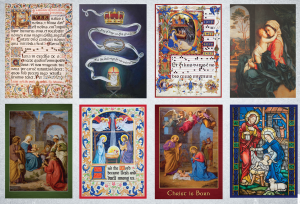
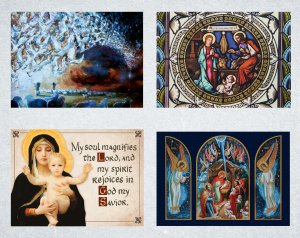
Liber Hymnorum: Why are these hymns important?
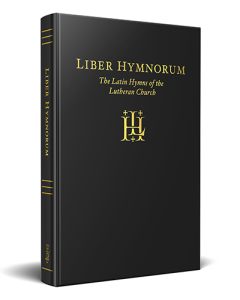 Matthew Carver: “The hymns in Liber Hymnorum are important, first, because they are the Church’s hymns. They have been used by God’s people for centuries, have stood the test of time, and have been carefully tended and passed on for the use of every generation. In them we find our own prayers, praises, and thanks to the Triune God joined with those of the saints of every age. This collection, in particular, is also important because it features the peculiar forms of the melodies as they ‘grew up’ and took on their own ‘accent’ in the bosom of the medieval church of Germany. A lot of people familiar with ancient hymns are nevertheless unaware of the rich multiplicity of ancient hymn tunes from the times before later scholars normalized, and yet sadly erased, many of these beautiful peculiarities. Thus we are at the same time given a window into the musical culture of the early Lutheran period in Germany.”
Matthew Carver: “The hymns in Liber Hymnorum are important, first, because they are the Church’s hymns. They have been used by God’s people for centuries, have stood the test of time, and have been carefully tended and passed on for the use of every generation. In them we find our own prayers, praises, and thanks to the Triune God joined with those of the saints of every age. This collection, in particular, is also important because it features the peculiar forms of the melodies as they ‘grew up’ and took on their own ‘accent’ in the bosom of the medieval church of Germany. A lot of people familiar with ancient hymns are nevertheless unaware of the rich multiplicity of ancient hymn tunes from the times before later scholars normalized, and yet sadly erased, many of these beautiful peculiarities. Thus we are at the same time given a window into the musical culture of the early Lutheran period in Germany.”
_____________
An endorsement from Dr. Robin Leaver, Visiting Professor, Yale University; Honorary Professor, Queen’s University: “Many Lutherans have forgotten – or do not know – that Latin hymns were not banished when Luther created his sturdy German hymns, but both continued side by side in the liturgical and devotional life of the early Lutheran churches. A simplistic equation has often been presented: Latin hymns are Catholic; vernacular hymns are Lutheran. But the sensitivity towards some Latin hymns was not linguistic but theological. Since the Reformation was nurtured and promoted by Latin schools, Latin hymns – corrected if necessary, as well as newly written – continued to be sung by the Latin scholars. This singing was often in alternation, with scholars singing each stanza in Latin and the parishioners following with the same stanza in German. This valuable collection, which is based on early Lutheran sources, on the one hand, witnesses to the historic Lutheran tradition of Latin hymnody, and on the other, is a practical collection of Latin hymns with English translations. The Latin hymns can be sung in seminaries and conferences where Latin is known and the vernacular versions sung from time to time in parishes. And there is also the possibility of experiencing the early Lutheran tradition of singing the alternate stanzas of a hymn in Latin and the vernacular. We are indebted to Matthew Carver for drawing our attention to this neglected liturgical tradition and for making these texts, translations, and music accessible.”
